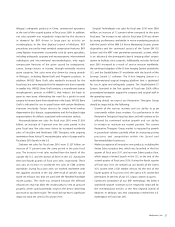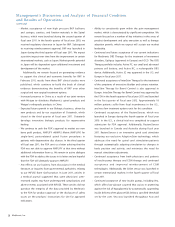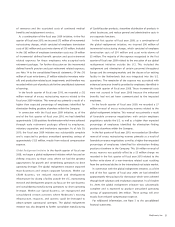Medtronic 2011 Annual Report Download - page 25
Download and view the complete annual report
Please find page 25 of the 2011 Medtronic annual report below. You can navigate through the pages in the report by either clicking on the pages listed below, or by using the keyword search tool below to find specific information within the annual report.21
Medtronic, Inc.
compare our recurring results over multiple periods. Investors
should consider this non-GAAP measure in addition to, and not as
a substitute for, financial performance measures prepared in
accordance with U.S. GAAP. In addition, this non-GAAP financial
measure may not be the same as similar measures presented by
other companies.
Tax regulations require certain items to be included in the tax
return at different times than when those items are required to be
recorded in the consolidated financial statements. As a result, our
effective tax rate reflected in our consolidated financial statements
is different than that reported in our tax returns. Some of
these differences are permanent, such as expenses that are not
deductible on our tax return, and some are temporary differences,
such as depreciation expense. Temporary differences create
deferred tax assets and liabilities. Deferred tax assets generally
represent items that can be used as a tax deduction or credit in
our tax return in future years for which we have already recorded
the tax benefit in our consolidated statements of earnings. We
establish valuation allowances for our deferred tax assets when
the amount of expected future taxable income is not likely to
support the use of the deduction or credit. Deferred tax liabilities
generally represent tax expense recognized in our consolidated
financial statements for which payment has been deferred or
expense has already been taken as a deduction on our tax return
but has not yet been recognized as an expense in our consolidated
statements of earnings.
The Company’s overall tax rate including the tax impact of
restructuring charges, certain litigation charges, net, and
acquisition-related items has resulted in an effective tax rate of
16.8 percent for fiscal year 2011. Excluding the impact of the
restructuring charges, certain litigation charges, net, and
acquisition-related items, our operational and tax strategies have
resulted in a non-GAAP nominal tax rate of 17.1 percent versus
the U.S. Federal statutory rate of 35.0 percent. An increase in our
non-GAAP nominal tax rate of 1.0 percent would have resulted in
an additional income tax provision for the fiscal year ended April
29, 2011 of approximately $43 million. See the discussion of our
tax rate and tax adjustments in the “Income Taxes” section of this
management’s discussion and analysis.
Valuation of IPR&D, Contingent Consideration, Goodwill, and
Other Intangible Assets When we acquire a business, the purchase
price is allocated, as applicable, among IPR&D, other identifiable
intangible assets, net tangible assets, and goodwill as required
by U.S. GAAP. IPR&D is defined as the value assigned to those
projects for which the related products have not received
regulatory approval and have no alternative future use.
Determining the portion of the purchase price allocated to IPR&D
and other intangible assets requires us to make significant
estimates. The amount of the purchase price allocated to IPR&D
and other intangible assets is determined by estimating the future
cash flows of each project or technology and discounting the
net cash flows back to their present values. The discount rate
used is determined at the time of the acquisition in accordance
with accepted valuation methods. For IPR&D, these valuation
methodologies include consideration of the risk of the project not
achieving commercial feasibility.
Contingent consideration is recorded at the acquisition date at
the estimated fair value of the contingent consideration milestone
payments for all acquisitions subsequent to April 24, 2009. The
acquisition date fair value is measured based on the consideration
expected to be transferred (probability-weighted), discounted
back to present value. The discount rate used is determined at the
time of the acquisition in accordance with accepted valuation
methods. The fair value of the contingent milestone consideration
is remeasured at the estimated fair value at each reporting period
with the change in fair value recorded as income or expense in
the acquisition-related items within our consolidated statements
of earnings.
Goodwill represents the excess of the aggregate purchase price
over the fair value of net assets, including IPR&D, of acquired
businesses. Goodwill is tested for impairment annually or more
frequently if changes in circumstance or the occurrence of
triggering events suggest that the carrying amount may be
impaired.
The test for impairment requires us to make several estimates
about fair value, most of which are based on projected future
cash flows. Our estimates associated with the goodwill impairment
test are considered critical due to the amount of goodwill
recorded on our consolidated balance sheets and the judgment
required in determining fair value, including projected future cash
flows. Goodwill was $9.537 billion and $8.391 billion as of April 29,
2011 and April 30, 2010, respectively.
Other intangible assets include patents, trademarks, purchased
technology, and IPR&D. Intangible assets with a definite life are
amortized on a straight-line or accelerated basis, as appropriate,
with estimated useful lives ranging from three to 20 years. We
review all intangible assets for impairment annually or as changes
in circumstance or the occurrence of events suggest the remaining
value may not be recoverable. Other intangible assets, net of
accumulated amortization, were $2.777 billion and $2.559 billion
as of April 29, 2011 and April 30, 2010, respectively.
























